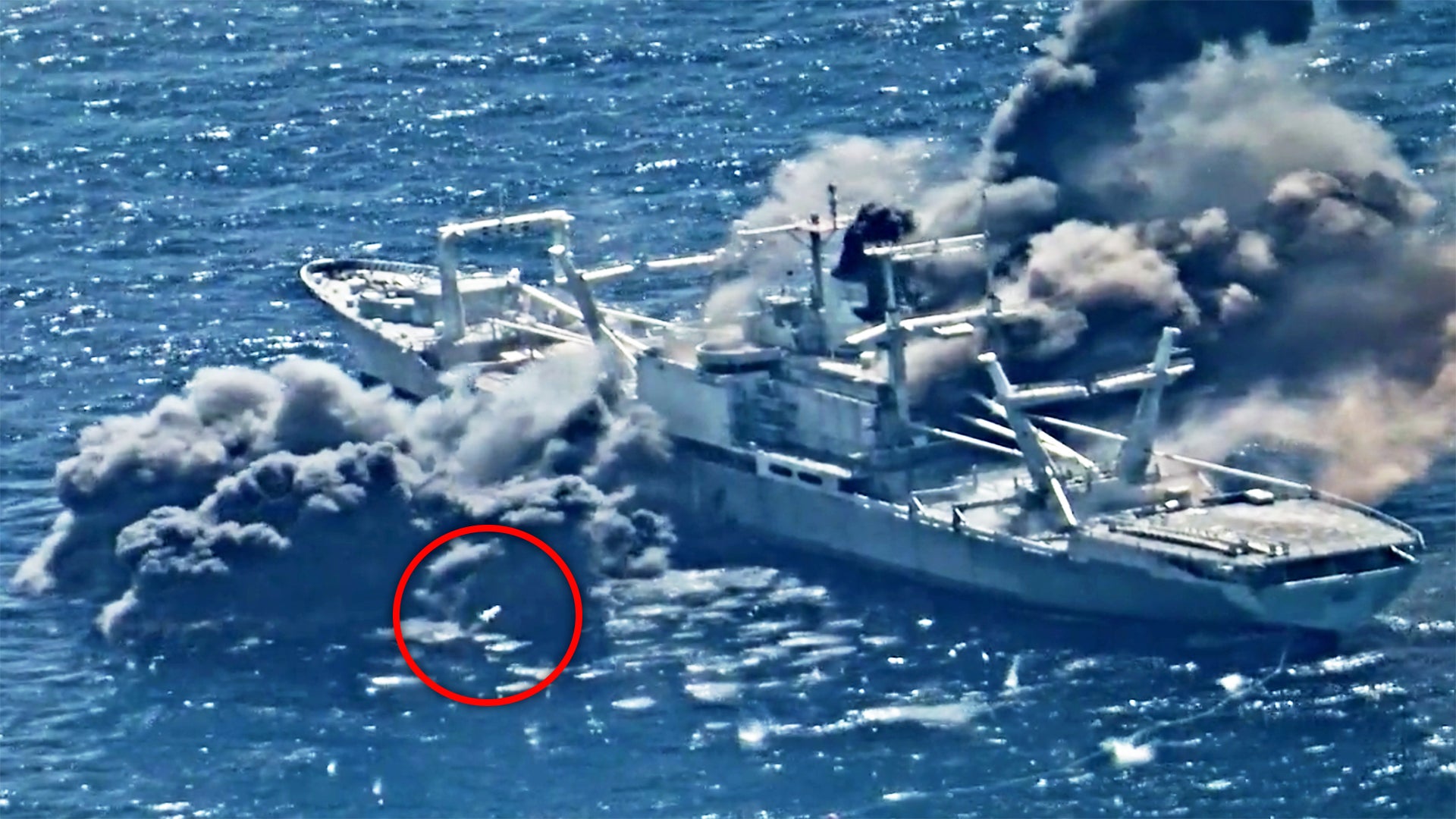Even though this iteration of the biennial Rim Of The Pacific (RIMPAC) international naval exercises off Hawaii is smaller than in years past, the highlight of the drills, where a real ship is sunk with live weaponry, wasn’t dropped from the program. For the sinking exercise, otherwise known as SINKEX, the ex-USS Durham, a mothballed amphibious cargo ship that was pulled from service in 1994, was the target. The Navy has released the first video of its demise, which appears to show a succession of no less than three anti-ship cruise missiles ripping through the ship’s hull and detonating, along with a showering of shrapnel or submunitions from another weapon.

Still-frames from the video show an anti-ship cruise missile, very likely an RGM-84 Harpoon, skimming just above the waves before punching through the left side of the ship’s hull and detonating. This is followed by two more missiles, striking amidships, just above the waterline, in a remarkably compact cluster. Between missiles two and three, a showering of objects appears to impact the water next to the ship. An object flies into the frame from left to right just prior to the splashes appearing. This appears to have been a cluster/area effects weapon, like an air-burst shell from a deck gun, or possibly an older air-launched JSOW or guided rocket artillery.



The Harpoon starred in the last SINKEX, as well, in a test that led to the venerable anti-ship missiles being reintegrated onto some of the U.S. Navy’s nuclear attack submarines. You can read all about this and the latest version of Harpoon here and here.
Often times, the Navy will steadily release more info about the SINKEX and who and what was involved as time goes on, but they have already offered this statement with some general details:
Live fire from ships and aircraft participating in the Rim of the Pacific (RIMPAC) exercise sank the decommissioned amphibious cargo ship ex-USS Durham (LKA 114), Aug. 30.
The sinking exercise (SINKEX) provided participating units the opportunity to gain proficiency and confidence in their weapons and systems through realistic training that could not be duplicated in simulators.
“Simulation is a critical part of our training but there is nothing better than to conduct live fire training,” said Royal Australian Navy Capt. Phillipa Hay, commander, RIMPAC 2020 Task Force One. “Sinking exercises are an important way to test our weapons and weapons systems in the most realistic way possible. It demonstrates as a joint force we are capable of high-end warfare.”
Former Navy vessels used in SINKEXs, referred to as hulks, are prepared in strict compliance with regulations prescribed and enforced by the Environmental Protection Agency under a general permit the Navy holds pursuant to the Marine Protection, Research and Sanctuaries Act.
Each SINKEX is required to sink the hulk in at least 1,000 fathoms (6,000 feet) of water and at least 50 nautical miles from land. Surveys are conducted to ensure people and marine mammals are not in an area where they could be harmed during the event.
Prior to being transported for participation in a SINKEX, each vessel is put through a rigorous cleaning process, including the removal of all liquid polychlorinated biphenyls (PCBs) from transformers and large capacitors, small capacitors to the greatest extent practical, and all trash, floatable materials, mercury or fluorocarbon-containing materials, and readily detachable solid PCB items. Petroleum is also cleaned from tanks, piping, and reservoirs.
A Navy environmental, safety and health manager and a quality assurance supervisor inspect the environmental remediation conducted in preparation of a vessel’s use in a SINKEX. Upon completion of the environmental remediation, the manager and supervisor provide signed certification of the work in accordance with EPA requirements.
Ex-Durham was a Charleston-class amphibious cargo ship commissioned on May 24, 1969, and was decommissioned on February 25, 1994. The ship was named for Durham, North Carolina, and served during the Gulf War.
Ten nations, 22 surface ships, one submarine, and approximately 5,300 personnel are participating in RIMPAC from Aug. 17 to 31 in the waters surrounding the Hawaiian Islands. The at-sea-only construct for RIMPAC 2020 was developed to ensure the safety of all military forces participating, and Hawaii’s population, by minimizing shore-based contingents, while striking a balance between combating future adversaries and the COVID-19 threat.
RIMPAC provides a unique training opportunity designed to foster and sustain cooperative relationships that are critical to ensuring the safety of sea lanes and security on the world’s interconnected oceans. RIMPAC 2020 is the 27th exercise in the series that began in 1971.


We will update this piece throughout the day if more info on the SINKEX becomes available.
UPDATE: 2:10AM PST—
Upon a closer examination of the video, I noticed that there appears to have been a 4th missile that arrives just prior to the first perpendicular impact of the string of three missiles. It appears to have been a low aspect/head-on attack profile shot and the missile seems to of just missed or glanced off the hull.
Typically, we never see these types of engagements, with the anti-ship cruise missiles making their terminal runs at the sides of the ship, where the vessel presents the best aspect (largest target) and signature. I am curious if this was an intentional low-aspect shot test of some sort. If it did hit, it would have skewered the ship with two missiles attacking from perpendicular vectors and impacting at roughly the same time.
Regardless, we know at least one other anti-ship missile was fired at the doomed vessel, making the count four confirmed. It still isn’t clear what the area effects weapon was.
The missile comes into the frame around the end of the 12-second mark and is out of the frame with a splash in the 14th second of the video:


Contact the author: Tyler@thedrive.com
